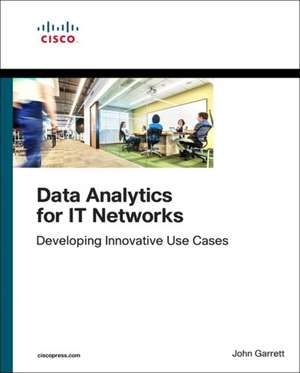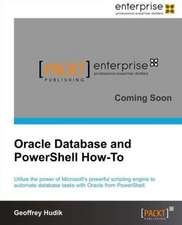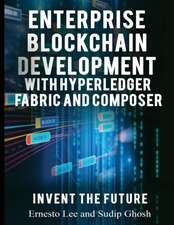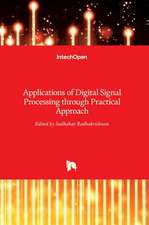Data Analytics for IT Networks: Networking Technology
Autor John Garretten Limba Engleză Paperback – 24 ian 2019
Din seria Networking Technology
- 20%
 Preț: 302.73 lei
Preț: 302.73 lei - 20%
 Preț: 477.27 lei
Preț: 477.27 lei - 20%
 Preț: 319.14 lei
Preț: 319.14 lei - 20%
 Preț: 319.00 lei
Preț: 319.00 lei - 20%
 Preț: 309.98 lei
Preț: 309.98 lei - 20%
 Preț: 319.12 lei
Preț: 319.12 lei - 20%
 Preț: 320.89 lei
Preț: 320.89 lei - 20%
 Preț: 326.70 lei
Preț: 326.70 lei - 20%
 Preț: 380.64 lei
Preț: 380.64 lei - 20%
 Preț: 304.73 lei
Preț: 304.73 lei - 20%
 Preț: 301.32 lei
Preț: 301.32 lei - 20%
 Preț: 318.34 lei
Preț: 318.34 lei - 20%
 Preț: 242.24 lei
Preț: 242.24 lei - 20%
 Preț: 306.58 lei
Preț: 306.58 lei - 20%
 Preț: 317.90 lei
Preț: 317.90 lei - 20%
 Preț: 350.30 lei
Preț: 350.30 lei - 20%
 Preț: 558.10 lei
Preț: 558.10 lei - 20%
 Preț: 325.98 lei
Preț: 325.98 lei - 20%
 Preț: 423.86 lei
Preț: 423.86 lei - 20%
 Preț: 326.16 lei
Preț: 326.16 lei - 20%
 Preț: 379.19 lei
Preț: 379.19 lei
Preț: 321.91 lei
Preț vechi: 402.39 lei
-20% Nou
Puncte Express: 483
Preț estimativ în valută:
61.61€ • 64.08$ • 51.63£
61.61€ • 64.08$ • 51.63£
Carte disponibilă
Livrare economică 21 februarie-07 martie
Livrare express 06-12 februarie pentru 46.71 lei
Preluare comenzi: 021 569.72.76
Specificații
ISBN-13: 9781587145131
ISBN-10: 1587145138
Pagini: 496
Dimensiuni: 190 x 230 x 20 mm
Greutate: 0.87 kg
Editura: Pearson Education (US)
Seria Networking Technology
ISBN-10: 1587145138
Pagini: 496
Dimensiuni: 190 x 230 x 20 mm
Greutate: 0.87 kg
Editura: Pearson Education (US)
Seria Networking Technology
Notă biografică
John Garrett is CCIE Emeritus (6204) and Splunk Certified. He earned an M.S. in predictive analytics from Northwestern University, and has a patent pending related to analysis of network devices with data science techniques. John has architected, designed, and implemented LAN, WAN, wireless, and data center solutions for some of the largest Cisco customers. As a secondary role, John has worked with teams in the Cisco Services organization to innovate on some of the most widely used tools and methodologies at Customer Experience over the past 12 years.
For the past 7 years, John's journey has moved through server virtualization, network virtualization, OpenStack and cloud, network functions virtualization (NFV), service assurance, and data science. The realization that analytics and data science play roles in all these brought John full circle back to developing innovative tools and techniques for Cisco Services. John's most recent role is as an Analytics Technical Lead, developing use cases to benefit Cisco Services customers as part of Business Critical Services for Cisco. John lives with his wife and children in Raleigh, North Carolina.
For the past 7 years, John's journey has moved through server virtualization, network virtualization, OpenStack and cloud, network functions virtualization (NFV), service assurance, and data science. The realization that analytics and data science play roles in all these brought John full circle back to developing innovative tools and techniques for Cisco Services. John's most recent role is as an Analytics Technical Lead, developing use cases to benefit Cisco Services customers as part of Business Critical Services for Cisco. John lives with his wife and children in Raleigh, North Carolina.
Cuprins
Foreword xvii Introduction: Your future is in your hands! xviii Chapter 1 Getting Started with Analytics 1 What This Chapter Covers 1 Data: You as the SME 2 Use-Case Development with Bias and Mental Models 2 Data Science: Algorithms and Their Purposes 3 What This Book Does Not Cover 4 Building a Big Data Architecture 4 Microservices Architectures and Open Source Software 5 R Versus Python Versus SAS Versus Stata 6 Databases and Data Storage 6 Cisco Products in Detail 6 Analytics and Literary Perspectives 7 Analytics Maturity 7 Knowledge Management 8 Gartner Analytics 8 Strategic Thinking 9 Striving for "Up and to the Right" 9 Moving Your Perspective 10 Hot Topics in the Literature 11 Summary 12 Chapter 2 Approaches for Analytics and Data Science 13 Model Building and Model Deployment 14 Analytics Methodology and Approach 15 Common Approach Walkthrough 16 Distinction Between the Use Case and the Solution 18 Logical Models for Data Science and Data 19 Analytics as an Overlay 20 Analytics Infrastructure Model 22 Summary 33 Chapter 3 Understanding Networking Data Sources 35 Planes of Operation on IT Networks 36 Review of the Planes 40 Data and the Planes of Operation 42 Planes Data Examples 44 A Wider Rabbit Hole 49 A Deeper Rabbit Hole 51 Summary 53 Chapter 4 Accessing Data from Network Components 55 Methods of Networking Data Access 55 Pull Data Availability 57 Push Data Availability 61 Control Plane Data 67 Data Plane Traffic Capture 68 Packet Data 70 Other Data Access Methods 74 Data Types and Measurement Considerations 76 Numbers and Text 77 Data Structure 82 Data Manipulation 84 Other Data Considerations 87 External Data for Context 89 Data Transport Methods 89 Transport Considerations for Network Data Sources 90 Summary 96 Chapter 5 Mental Models and Cognitive Bias 97 Changing How You Think 98 Domain Expertise, Mental Models, and Intuition 99 Mental Models 99 Daniel Kahneman's System 1 and System 2 102 Intuition 103 Opening Your Mind to Cognitive Bias 104 Changing Perspective, Using Bias for Good 105 Your Bias and Your Solutions 106 How You Think: Anchoring, Focalism, Narrative Fallacy, Framing, and Priming 107 How Others Think: Mirroring 110 What Just Happened? Availability, Recency, Correlation, Clustering, and Illusion of Truth 111 Enter the Boss: HIPPO and Authority Bias 113 What You Know: Confirmation, Expectation, Ambiguity, Context, and Frequency Illusion 114 What You Don't Know: Base Rates, Small Numbers, Group Attribution, and Survivorship 117 Your Skills and Expertise: Curse of Knowledge, Group Bias, and Dunning-Kruger 119 We Don't Need a New System: IKEA, Not Invented Here, Pro-Innovation, Endowment, Status Quo, Sunk Cost, Zero Price, and Empathy 121 I Knew It Would Happen: Hindsight, Halo Effect, and Outcome Bias 123 Summary 124 Chapter 6 Innovative Thinking Techniques 127 Acting Like an Innovator and Mindfulness 128 Innovation Tips and Techniques 129 Developing Analytics for Your Company 140 Defocusing, Breaking Anchors, and Unpriming 140 Lean Thinking 142 Cognitive Trickery 143 Quick Innovation Wins 143 Summary 144 Chapter 7 Analytics Use Cases and the Intuition Behind Them 147 Analytics Definitions 150 How to Use the Information from This Chapter 151 Priming and Framing Effects 151 Analytics Rube Goldberg Machines 151 Popular Analytics Use Cases 152 Machine Learning and Statistics Use Cases 153 Common IT Analytics Use Cases 170 Broadly Applicable Use Cases 199 Some Final Notes on Use Cases 214 Summary 214 Chapter 8 Analytics Algorithms and the Intuition Behind Them 217 About the Algorithms 217 Algorithms and Assumptions 218 Additional Background 219 Data and Statistics 221 Statistics 221 Correlation 224 Longitudinal Data 225 ANOVA 227 Probability 228 Bayes' Theorem 228 Feature Selection 230 Data-Encoding Methods 232 Dimensionality Reduction 233 Unsupervised Learning 234 Clustering 234 Association Rules 240 Sequential Pattern Mining 243 Collaborative Filtering 244 Supervised Learning 246 Regression Analysis 246 Classification Algorithms 248 Decision Trees 249 Random Forest 250 Gradient Boosting Methods 251 Neural Networks 252 Support Vector Machines 258 Time Series Analysis 259 Text and Document Analysis 262 Natural Language Processing (NLP) 262 Information Retrieval 263 Topic Modeling 265 Sentiment Analysis 266 Other Analytics Concepts 267 Artificial Intelligence 267 Confusion Matrix and Contingency Tables 267 Cumulative Gains and Lift 269 Simulation 271 Summary 271 Chapter 9 Building Analytics Use Cases 273 Designing Your Analytics Solutions 274 Using the Analytics Infrastructure Model 275 About the Upcoming Use Cases 276 The Data 276 The Data Science 278 The Code 280 Operationalizing Solutions as Use Cases 281 Understanding and Designing Workflows 282 Tips for Setting Up an Environment to Do Your Own Analysis 282 Summary 284 Chapter 10 Developing Real Use Cases: The Power of Statistics 285 Loading and Exploring Data 286 Base Rate Statistics for Platform Crashes 288 Base Rate Statistics for Software Crashes 299 ANOVA 305 Data Transformation 310 Tests for Normality 311 Examining Variance 313 Statistical Anomaly Detection 318 Summary 321 Chapter 11 Developing Real Use Cases: Network Infrastructure Analytics 323 Human DNA and Fingerprinting 324 Building Search Capability 325 Loading Data and Setting Up the Environment 325 Encoding Data for Algorithmic Use 328 Search Challenges and Solutions 331 Other Uses of Encoded Data 336 Dimensionality Reduction 337 Data Visualization 340 K-Means Clustering 344 Machine Learning Guided Troubleshooting 350 Summary 353 Chapter 12 Developing Real Use Cases: Control Plane Analytics Using Syslog Telemetry 355 Data for This Chapter 356 OSPF Routing Protocols 357 Non-Machine Learning Log Analysis Using pandas 357 Noise Reduction 360 Finding the Hotspots 362 Machine Learning-Based Log Evaluation 366 Data Visualization 367 Cleaning and Encoding Data 369 Clustering 373 More Data Visualization 375 Transaction Analysis 379 Task List 386 Summary 387 Chapter 13 Developing Real Use Cases: Data Plane Analytics 389 The Data 390 SME Analysis 394 SME Port Clustering 407 Machine Learning: Creating Full Port Profiles 413 Machine Learning: Creating Source Port Profiles 419 Asset Discovery 422 Investigation Task List 423 Summary 424 Chapter 14 Cisco Analytics 425 Architecture and Advisory Services for Analytics 426 Stealthwatch 427 Digital Network Architecture (DNA) 428 AppDynamics 428 Tetration 430 Crosswork Automation 431 IoT Analytics 432 Analytics Platforms and Partnerships 433 Cisco Open Source Platform 433 Summary 434 Chapter 15 Book Summary 435 Analytics Introduction and Methodology 436 All About Networking Data 438 Using Bias and Innovation to Discover Solutions 439 Analytics Use Cases and Algorithms 439 Building Real Analytics Use Cases 440 Cisco Services and Solutions 442 In Closing 442 Appendix A Function for Parsing Packets from pcap Files 443 9781587145131, TOC, 9/19/18

















